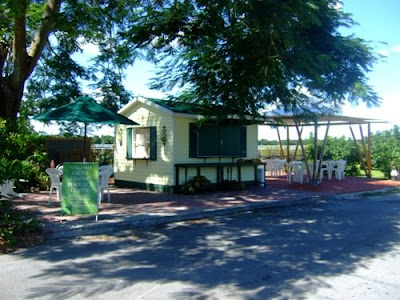 The entrance to Williams Grove. In season, you can buy fruit here on Saturdays.
The entrance to Williams Grove. In season, you can buy fruit here on Saturdays.
Last week was a little unusual because instead of working at the fruit pavilion I headed down to the Redlands. I spent the day gathering information for an article about tropical fruit I plan to publish at
Miami Beach 411 and came home with an additional bounty of material for this blog, which I will share in the coming weeks.
I spent the first part of the day at Fairchild's agricultural station,
Williams Grove -- 20 acres donated by Frank Williams in 2002. About 80% of the grove is commercial and consists of the avocado trees originally planted there by Williams; the remaining percent forms part of Fairchild's living genetic collection, which features mango, mamey americana, jackfruit, canistel, spanish lime, caimito, mamey sapote and avocado. None of these trees are domesticated but rather grew from specimens brought over from other countries in collecting expeditions. The work involved in bringing those specimens to the states is another post in itself!
Noris Ledesma, Curator of Tropical Fruit, gave me a tour of the house and the property, taught me how to graft a tree and gave me a grafted mamey sapote plant to take home. I could really tell how much love and care has gone into the development of this property, much of it done with the help of volunteers.
I also spent time with Senior Curator of Tropical Fruit, Dr. Richard Campbell talking about his background as well as his family's -- he's a second generation Redlands agricultural expert. He also covered the process of running the farm and growing trees. The scientific research done in the fruit program as well as the day-to-day work in maintaining a thriving collection is truly impressive. It takes more than book learning to truly and deeply understand these trees and Richard's passion for the work is readily apparent.
Both Noris and Richard were very welcoming and eager to share. The pair of geese on the farm, however, were not so warm. Every time I walked by, they tried to peck at my feet in unrelenting attack!
 Talk about homeland security, this feathery patrol would have nothing to do with me!
Talk about homeland security, this feathery patrol would have nothing to do with me!
The second part of the day I spent at the
Fruit and Spice Park with Director Chris Rollins, who gave me a tour. The number and variety of plants there is dizzying! The park is undergoing some expansion now. They're digging a large lake that will feature a waterfall and aquatic plants.
Overall, I left the Redlands with a greater appreciation not only for tropical plants but also for the rich agricultural history right in our own backyard. I definitely plan to spend more time there in the future. It's such a refreshing respite from the city and getting there by way of historic
Old Cutler Road makes it even better. Stay tuned for more detailed posts about what this city girl learned in the Redlands that day!
On a side note, Fairchild asked to feature me as volunteer in the next edition of their gorgeous publication, Tropical Garden Magazine. I was very flattered, not to mention honored! I'm not sure when the next edition comes out, but you can browse past editions online
here.
 Photo by Jagosaurus on Flickr.
Photo by Jagosaurus on Flickr.













